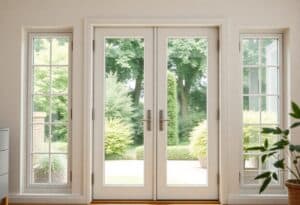Doors are one of the most important parts of a home, and it’s important to make sure they’re functional and energy-efficient. In this blog post, we’ll discuss what U-Value is and how it relates to your doors.
What is U-Value?
The U-value is a measure of the heat transfer through a material. It is the rate of heat loss (in watts) through one square metre of the material when there is a temperature difference of one degree Celsius between the two surfaces. The lower the U-value, the better the thermal performance of the material.
In other words, the U-value measures how well a material conducts heat. The lower the U-value, the better it is at insulating against heat loss. When it comes to energy efficiency in buildings, we are always looking for ways to reduce heat loss and keep our homes warm in winter and cool in summer. One way to do this is by using materials with low U-values in our construction.
There are three main ways that heat can be transferred: conduction, convection and radiation. Conduction is where heat moves through a solid material like metal or glass. Convection is where heat moves through fluids like air or water. Radiation is where heat moves through space as electromagnetic waves – this includes infrared radiation from things like hot surfaces or sunlight coming through windows
What is R-Value?
The R-value is a measure of a material’s resistance to heat flow. The higher the R-value, the better the insulation.
There are two types of R-values:
1) The R-value of an insulating material itself, which is a measure of how well that material resists heat flow; and
2) The R-value of an assembly of materials, which is a measure of how well the assembly as a whole resists heat flow.
The R-value of an assembly includes not only the contribution of the actual insulating material, but also any other materials in the assembly that affect heat flow (such as wood or metal framing).
What is the Difference Between U-Value and R-Value?
The R-value is a measure of a material’s resistance to heat flow. The higher the R-value, the more effective the material is at insulating. The U-value measures how well a material conducts heat. The lower the U-value, the better the material is at preventing heat transfer.
How Does U-Value Relate to My Doors?
The U-value of a door measures how well the door prevents heat from escaping. The lower the U-value, the better the door is at insulating your home. Doors with a low U-value can help you save money on your energy bills by keeping your home warmer in the winter and cooler in the summer.
How Can I Improve My Door’s U-Value?
There are a number of things you can do to improve the U-value of your door. One is to make sure that it is properly insulated. Another is to install weather stripping around the door so that there is less air infiltration. Finally, you can also install a storm door to help further reduce heat loss.
What Are the Benefits of a Good U-Value?
A good U-Value is important for several reasons. Firstly, it indicates how well a material conducts heat. The lower the U-Value, the better the material is at insulating against heat loss. This is important in both hot and cold climates, as it can help to keep a building cool in summer and warm in winter. Secondly, a low U-Value can help to reduce energy bills. This is because less energy is required to maintain a comfortable temperature inside a well-insulated building. Finally, a good U-Value can also improve indoor air quality by reducing draughts and limiting the amount of heat that escapes from the building.
Are There Any Drawbacks to a High U-Value?
A high U-value means that a material is a good conductor of heat. This is generally seen as a good thing, as it means that heat can be transferred quickly and efficiently through the material. However, there are some circumstances in which a high U-value can be seen as a drawback.
For example, if you are using a material with a high U-value to insulate your home, it will also conduct heat out of your home easily. This means that your home will lose heat more quickly than if you had used a material with a lower U-value. In addition, materials with high U-values are often more expensive than those with lower U-values.
Overall, though, the benefits of using materials with high U-values usually outweigh the drawbacks. If you are concerned about losing heat from your home, you can always supplement insulation with other methods of heating, such as solar panels or space heaters.
How Can I Learn More About U-Values?
The importance of understanding U-values
U-values are a measure of heat loss in buildings, and as such are an important consideration in both the construction and thermal performance of buildings. In simple terms, the lower the U-value, the better the thermal performance of the building envelope.
There are a number of ways to improve the U-value of a building, including:
Improving the insulation levels within the walls, floors and ceilings.
Use of high-performance windows and doors.
Installation of external wall cladding or render.
Use of solar shading to reduce solar gain in summer months.
However, it is important to note that there is no “magic number” when it comes to U-values and that each project should be assessed on its own merits taking into account a range of factors such as climate, orientation and usage patterns.













